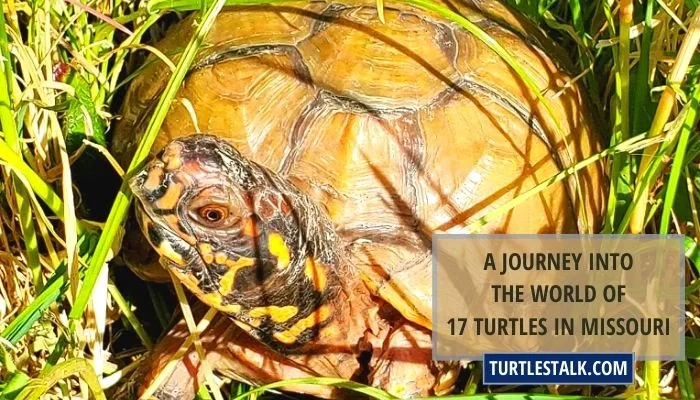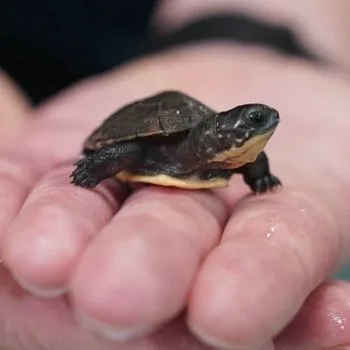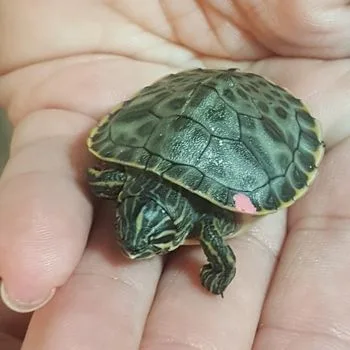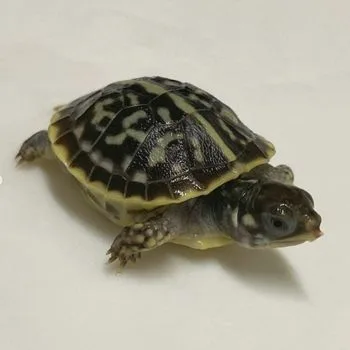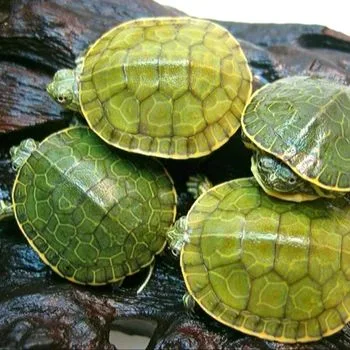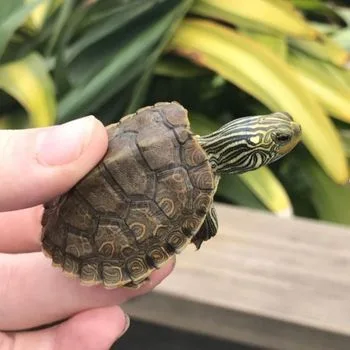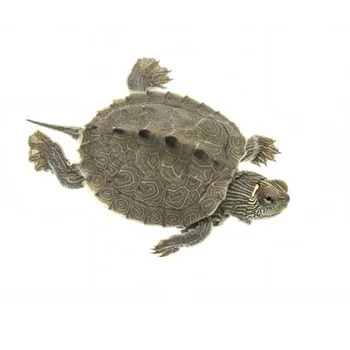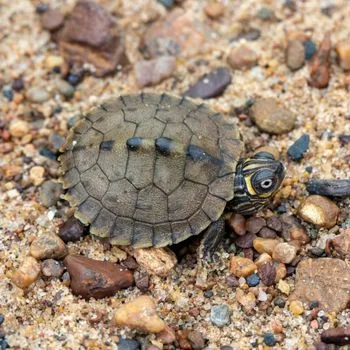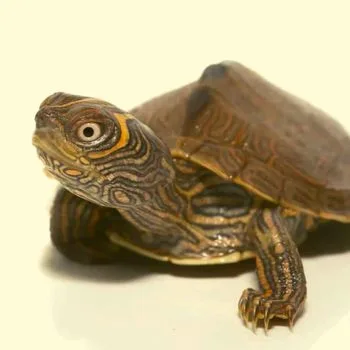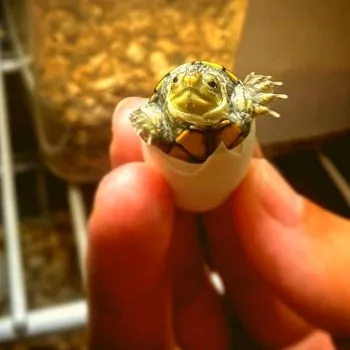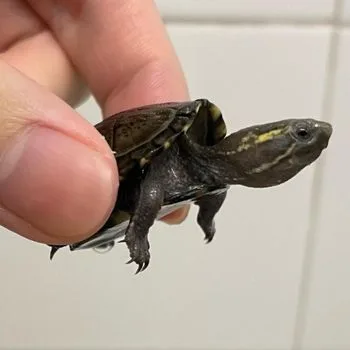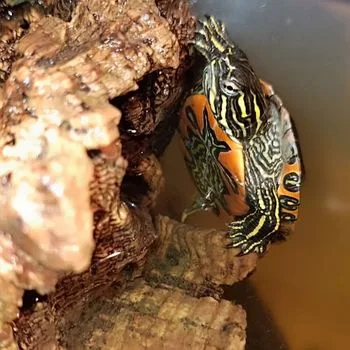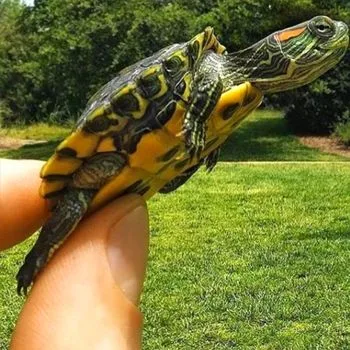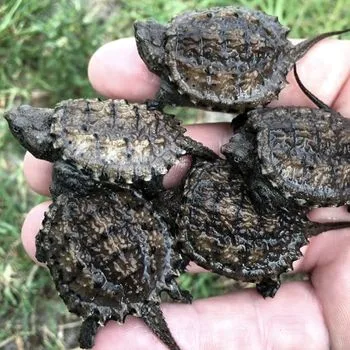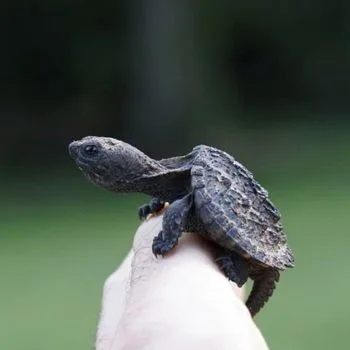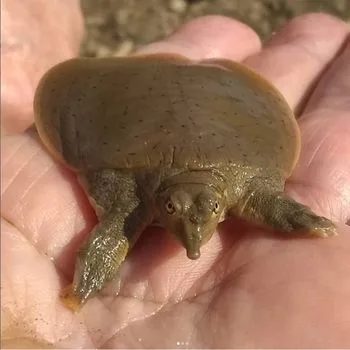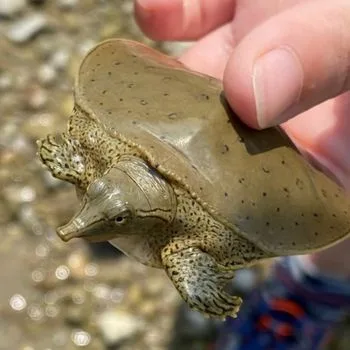A Journey Into the World of 17 Turtles in Missouri
Missouri is home to an incredible variety of turtles, from the hard-shelled aquatic species, to the soft-shelled varieties and even some land turtles.
If you’re looking for a unique wildlife experience, then look no further than Missouri! From snapping turtles to painted turtles, false map turtles and western box turtle – there are 17 different species that can be seen in their natural habitat at the Missouri National Recreational River (MNRR).
So if you want to come face-to-face with one of these amazing creatures, head on over and explore all that this region has to offer!
| # | Name | Details | Image |
| 1 | Blanding Turtle (Emydoidea Blandingii) |
| 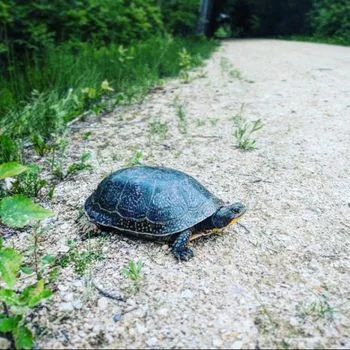 |
| 2 | Eastern River Cooter (Pseudemys Concinna) |
| 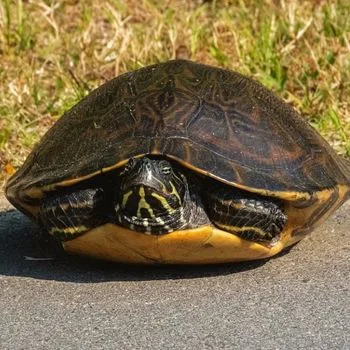 |
| 3 | Ornate Box Turtle (Terrapene Ornata Ornata) |
| 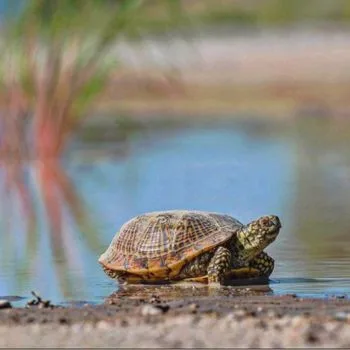 |
| 4 | Three-toed Box Turtle (Terrapene Carolina Triunguis) |
| 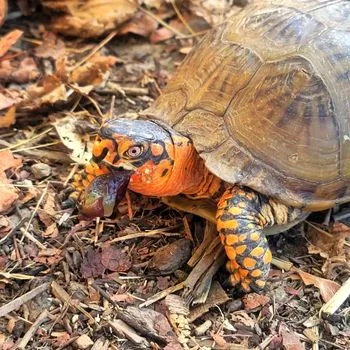 |
| 5 | Western Chicken Turtle (Deirochelys Reticularia Miaria) |
| 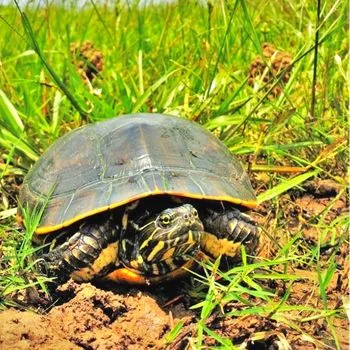 |
| 6 | Common Map Turtle (Graptemys Geographica) |
| 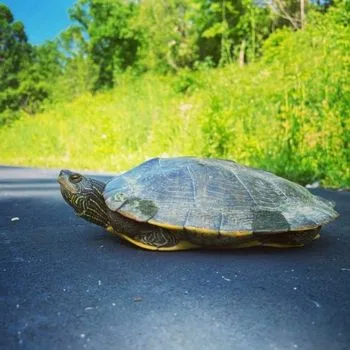 |
| 7 | False Map Turtle (Graptemys Pseudogeographica) |
| 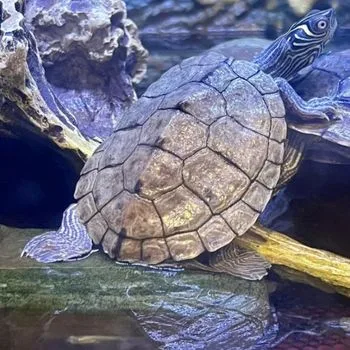 |
| 8 | Ouachita Map Turtle (Graptemys Ouachitensis) |
| 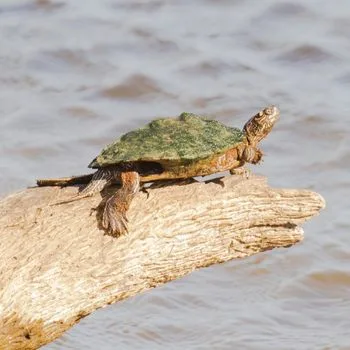 |
| 9 | Mississippi Mud Turtle (Kinosternon Subrubrum) |
| 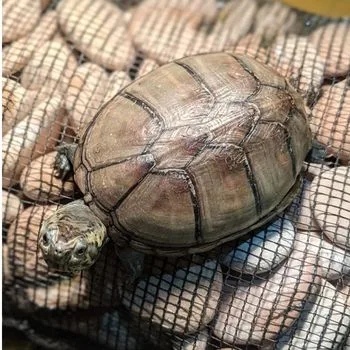 |
| 10 | Yellow Mud Turtle (Kinosternon Flavescens) |
| 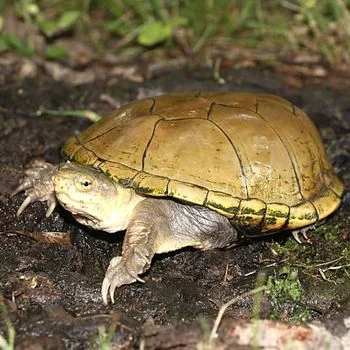 |
| 11 | Common Musk Turtle (Sternotherus Odoratus) |
| 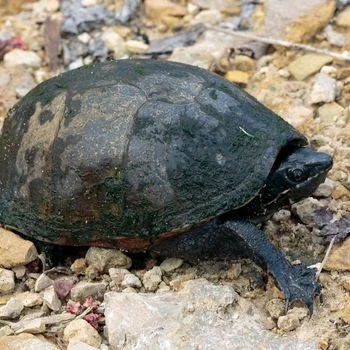 |
| 12 | Painted Turtle (Chrysemys picta) |
| 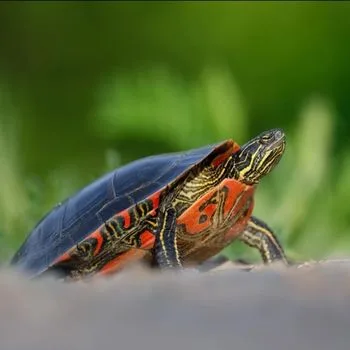 |
| 13 | Red Eared Slider (Trachemys Scripta Elegans) |
| 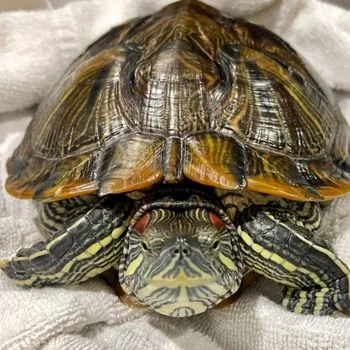 |
| 14 | Alligator Snapping Turtle (Macrochelys Temminckii) |
| 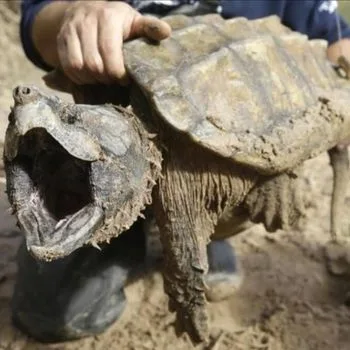 |
| 15 | Common Snapping Turtle (Chelydra serpentina) |
| 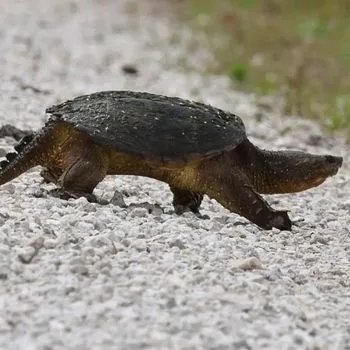 |
| 16 | Midland Smooth Softshell Turtle (Apalone mutica mutica) |
| 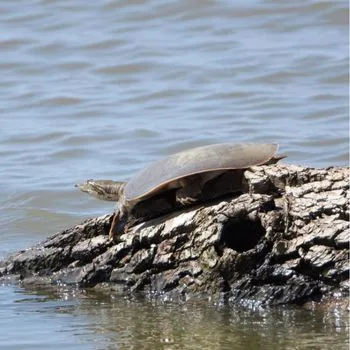 |
| 17 | Eastern Spiny Softshell Turtle (Apalone Spinifera) |
| 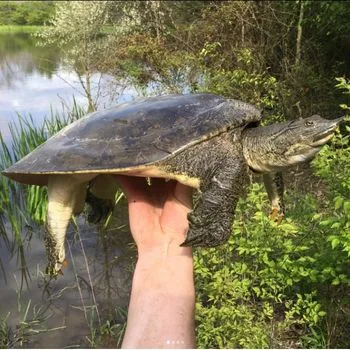 |
17 Turtles You Can Find in Missouri
In total, there are 17 species of turtles in the state of Missouri. This guide will take you on an exploration through each turtle type and provide tips for providing them with proper care. So, let’s get started on our journey into discovering all the wonders that these reptiles have to offer!
1. Blanding Turtle (Emydoidea Blandingii)
- Family: Emydidae
- Genus: Emydoidea
- Type: Freshwater turtle
- Natural Habitat: Marshes, swamps, ponds, and slow-moving streams in eastern north america
- Lifespan: 20-30 years
- Maximum Size: 8-10 inches in carapace length
- Maximum Weight: 1-2 pounds
- Prone to Diseases: Shell rot, respiratory infections, and skin infections
- Aggression Level: Mild
- Predators: Juveniles and eggs – raccoons, skunks, and birds; adults – large fish and otters
- Domestication: Not suitable as pets
Native to the marshes, swamps, ponds, and slow-moving streams of Eastern North America, the Blanding Turtle (Emydoidea Blandingii) is a freshwater turtle. Adults measure 8-10 inches in carapace length, and weigh around 1-2 pounds, with little variation between male and female sizes.
These turtles are mild and usually not aggressive, though juveniles and eggs can be preyed on by raccoons, skunks, and birds. Adult Blanding Turtles in Missouri can be preyed on by large fish, otters, and humans.
Due to habitat loss and exploitation for the pet trade, these turtles are listed as a Species of Special Concern in some states including Maine, New York, Ohio, and Indiana. However, they are not suitable as pets as they require specialized habitats to thrive. Furthermore, if kept captive they can suffer from illnesses like shell rot or respiratory infections if not maintained properly.
Blanding Turtles are strong swimmers well adapted to life in the water. Conservation efforts should continue in the state of Missouri in order to protect this species which plays an important role in maintaining healthy ecosystems within its range from Eastern North America.
Moreover, educational initiatives should be established to educate people about the significance of protecting these turtles before their population further declines.
2. Eastern River Cooter (Pseudemys Concinna)
- Family: Emydidae
- Genus: Pseudemys
- Type: Freshwater turtle
- Natural Habitat: Slow-moving rivers, swamps, and other aquatic environments
- Lifespan: 30 years
- Maximum Size: 11 inches
- Maximum Weight: 8 pounds
- Prone to Diseases: Respiratory infections, shell rot, and parasites
- Aggression Level: Not known to be aggressive
- Predators: Raccoons, foxes, etc.
- Domestication: Can be kept as pets
The Eastern River Cooter (Pseudemys concinna) is a beautiful freshwater turtle found in the southeastern United States, including states such as Alabama, Georgia, South Carolina, North Carolina and Florida. With its wide flat shell adorned with striking markings of yellow and red it’s certainly an impressive sight to behold.
These unique creatures typically grow up to 10-15 inches in length; males usually being smaller than females. They have strong webbed feet and streamlined shells that make them exceptionally adapted to aquatic environments like slow-moving rivers, swamps, and lakes of Missouri. In the wild they can live up to 30 years but if well looked after they can reach 20 or more years in captivity; making them attractive pet options for those looking for long term companionship.
Their natural habitats however are under threat due to human activity so by protecting their environment we can help ensure that this stunning species remain part of our ecosystem for many generations in Missouri.
3. Ornate Box Turtle (Terrapene Ornata Ornata)
- Family: Emydidae
- Genus: Terrapene
- Type: Terrestrial turtle
- Natural Habitat: Open landscapes such as pastures, prairies, and lightly forested areas
- Lifespan: 30 – 40 years
- Also Known As: Western box turtle
- Maximum Size: 4-5 inches
- Maximum Weight: 1-1.5 pounds
- Prone to Diseases: Vitamin deficiency, respiratory diseases
- Disease Carrier: Salmonella
- Aggression Level: Males display a tendency towards aggressive behavior, including biting and clashing their shells against each other
- Predators: Birds, such as crows, raptors, and ravens; domestic cats and dogs; opossums; raccoons; skunks; snakes; and even adult box turtles
- Domestication: Can be kept as pet
Have you ever wondered what kind of magical creature might be lurking in the forests and wetlands of Missouri? Well, say hello to the Ornate Box Turtle! This amazing animal is closely related to its box turtle cousins, but it can also be identified by its intricate patterned shell – hence its name.
With a small head and body covered in an ornately patterned carapace or upper shell that’s usually brown with yellowish-orange markings, these turtles stand out from the crowd.
It spends most of its time hiding under cover while searching for food such as snails and insects, often seen out on warm summer days. So next time you take a walk through Missouri, keep your eyes open for the Ornate Box Turtle – after all, who knows what else might be living there!
4. Three-toed Box Turtle (Terrapene Carolina Triunguis)
- Family: Emydidae
- Genus: Terrapene
- Type: Semi-aquatic turtle
- Natural Habitat: Humid areas such as marshes and grassy lands
- Lifespan: 30 – 40 years
- Maximum Size: 5 – 7 inches
- Maximum Weight: Up to 2 pounds
- Prone to Diseases: Clinical mycoplasma infections, mbd
- Disease Carrier: Salmonella
- Aggression Level: Not aggressive
- Predators: Mammals, such as raccoons, muskrats, birds and large fishes.
- Domestication: Illegal to possess without permit in most states
This remarkable reptile inhabits deciduous forests, grasslands, and wetlands across parts of the eastern and central United States including Missouri.
Its average length is 4.5 to 5.5 inches while its weight averages between 0.5 to 1 pound with no size or gender differences seen in adults. Although they are mild by nature, these reptiles need proper care and maintenance if kept as pets – some states like Florida have even put restrictions on owning them as a pet!
Fortunately, their strong shells protect them from predators like snakes, raccoons, and skunks; however human activities such as habitat destruction have resulted in this species being listed as a special concern in some states due to the loss of habitats.
5. Western Chicken Turtle (Deirochelys Reticularia Miaria)
- Family: Emydidae
- Genus: Deirochelys
- Type: Semi-aquatic turtle
- Natural Habitat: Lakes, swamps, ponds and streams characterized by slow pace and shallow depth.
- Lifespan: 15 – 25 years
- Maximum Size: Up to 10 inches
- Maximum Weight: 0.5 – 4 pounds
- Prone to Diseases: Respiratory diseases, metabolic bone issues
- Disease Carrier: Salmonella
- Aggression Level: Hostile behavior between males can be particularly noticeable.
- Predators: Raccoons, otters, ospreys, weasels, large fish and coyotes
- Domestication: Can be kept as pet if collected from a legal collector
Welcome to the remarkable world of the Western Chicken Turtle – a semi-aquatic species found across Missouri. These captivating creatures typically measure up to 10 inches in length and can weigh up to 4 pounds, making them one of the smallest turtles you may find.
Their shells have a distinctive patterned design featuring bright yellow and brown markings over an orange background, with unusually attractive wattle necks for heads! They’re also well-adapted for life in watery habitats such as ponds, lakes, swamps and streams; able to firmly grip slippery surfaces with webbed feet and even hold their breath for long periods of time!
Western Chicken Turtles make great pets if collected from legal collectors however they are quite hostile between males so please keep this in mind before taking one home. Be sure to look out for its predators too – raccoons, otters, ospreys and coyotes love these perfect little packages! Thankfully Western Chicken Turtles aren’t listed as endangered yet but it’s important that we take every opportunity we can to protect them.
6. Common Map Turtle (Graptemys Geographica)
- Family: Emydidae
- Genus: Graptemys
- Type: Aquatic turtle
- Natural Habitat: Freshwater rivers, streams, and ponds in the eastern united states
- Lifespan: 20 years
- Also Known As: Map turtle, northern map turtle
- Maximum Size: 8-10 inches
- Maximum Weight: 1-2 pounds
- Prone to Diseases: Respiratory infections and shell rot
- Aggression Level: Not aggressive
- Predators: Otters, raccoons, birds of prey, and large fish
- Domestication: Can be kept as pets
Deep in the freshwater rivers, streams and ponds of the eastern United States lies a remarkable species of turtle – the Common Map Turtle (Graptemys geographica). This species is part of the Emydidae family, and is well-adapted to aquatic life, boasting powerful webbed feet, a long neck and flat shell for swimming. Adults can grow up to 8-10 inches in length with little size variation between males and females, ranging from 1 to 2 pounds in weight.
The Common Map Turtle is often confused with other members of its genus; however, it can be easily identified by its unique pattern of yellow lines that resemble a map on its shell. Its lifespan can reach up to 20 years when kept in proper conditions. It’s important to note that this species is illegal to own as a pet in some states due to varying regulations; therefore it’s essential to check your local state laws before attempting ownership.
These turtles may not be aggressive by nature but they may bite if threatened or disturbed. They are also prone to diseases such as respiratory infections and shell rot if kept in unsanitary conditions – so it’s important to take special care when handling them if you decide to keep them as pets.
As far as predators go, otters, raccoons, birds of prey and large fish all pose a threat despite their adaptations for aquatic life. Thankfully, there are no signs that this magnificent species is currently endangered here in Missouri.
7. False Map Turtle (Graptemys Pseudogeographica)
- Family: Emydidae
- Genus: Graptemys
- Type: Freshwater turtle
- Natural Habitat: Large rivers, lakes and backwaters of the mississippi river system
- Lifespan: 10 to 20 years
- Maximum Size: Females 8-10 inches; males reach 4-6 inches
- Maximum Weight: Females 4 lbs; males 0.8 lbs
- Prone to Diseases: Respiratory infections, shell rot, and other health issues
- Aggression Level: Low
- Predators: Birds of prey, raccoons, and other large mammals
- Domestication: Can be kept as pets
False Map Turtles are freshwater turtles native to the large rivers, lakes and backwaters of the Mississippi River system. Males grow up to 6 inches in length and can weigh up to 0.8lbs, while females typically reach 8-10 inches in size and weigh 4 lbs.
This species is well adapted for aquatic life – with a streamlined shell and strong legs for swimming, they are graceful swimmers. Best known for their intricate map-like shell patterning, these turtles have relatively low levels of aggression so can be kept as pets under supervision with proper care and nutrition.
Despite not being considered endangered yet, we must protect False Map Turtle habitats throughout Missouri before populations decline further due to habitat loss or collection for the pet trade!
8. Ouachita Map Turtle (Graptemys Ouachitensis)
- Family: Emydidae
- Genus: Graptemys
- Type: Aquatic turtle
- Natural Habitat: Slow-moving freshwater rivers, streams, and lakes
- Lifespan: 30 – 50 years
- Also Known As: Sawback
- Maximum Size: Males: 3 to 6.5 inches, females: 4.0 to roughly 11 inches
- Maximum Weight: 1.5 – 4.5 pounds
- Prone to Diseases: Shell rot, respiratory infections
- Disease Carrier: Salmonella
- Aggression Level: Not aggressive
- Predators: Raccoons, skunks, and foxes
- Domestication: Can be kept as pet
Have you ever seen the magnificent Ouachita Map Turtle (Graptemys ouachitensis)? This freshwater turtle is found in slow-moving rivers, streams, and oxbow lakes in Arkansas and Oklahoma.
With adult sizes measuring 8-11 inches in length, these turtles make for a great pet – though it’s important to check local regulations as Missouri may have different restrictions when it comes to owning a turtle.
They are not aggressive by nature but can fall prey to predators like raccoons and otters or even large fish or birds of prey on occasion. When cared for properly, these turtles can live up to 20-30 years!
9. Mississippi Mud Turtle (Kinosternon Subrubrum)
- Family: Kinosternidae
- Genus: Kinosternon
- Type: Semi-aquatic turtle
- Natural Habitat: Lives close to stagnant or slow-moving water bodies such as swamps, ponds, ditches and oxbow lakes, preferring shallow, soft-bottomed areas with vegetation. seems to steer clear of fast-flowing rivers.
- Lifespan: 15 and 20+ years
- Maximum Weight: 10 to 35 pounds
- Prone to Diseases: Vitamin a deficiency, respiratory diseases, abscesses, shell infections and fractures, and parasites
- Disease Carrier: Salmonella
The Mississippi Mud Turtle that inhabits Missouri is a semi-aquatic turtle found near a variety of slow-moving water bodies such as swamps, ponds, and ditches. They can weigh anywhere between 10 to 35 pounds and live up to 20+ years in the wild if they manage to dodge any human-introduced danger.
It has an amazing defense mechanism: its strong shell allows it to protect itself from potential predators in their natural environment, while their salmonella carrier status makes handling them not recommended! While they can be kept as pets, proper care must be taken as they’re prone to some diseases like Vitamin A deficiency, respiratory diseases, abscesses and more.
With conservation efforts, future generations will get the chance to marvel over this magnificent reptile living harmoniously within nature.
10. Yellow Mud Turtle (Kinosternon Flavescens)
- Family: Kinosternidae
- Genus: Kinosternon
- Type: Freshwater turtle
- Natural Habitat: Found in habitats ranging from slow-moving rivers to permanent ponds, including floodplain swamps and seasonal wetlands.
- Lifespan: 20 – 30+ years
- Maximum Size: 5 – 12 inches
- Maximum Weight: 10 – 35 pounds
- Prone to Diseases: Shell disease
- Disease Carrier: Salmonella
- Aggression Level: Not aggressive
- Predators: Raccoons, alligators
- Domestication: Can be kept as pets
The Yellow Mud Turtle (Kinosternon flavescens) is a remarkable creature, found in habitats ranging from slow-moving rivers to permanent ponds. This freshwater turtle is typically 5 to 12 inches long and can live up to 30 plus years! It has an interesting yellowish shell with black markings on its upper carapace that sometimes feature red or orange hues along the edges; making it stand out among other species of turtles.
Yellow mud turtles are not aggressive creatures, preferring solitude apart from mating season when we often find several males competing for the same female. These reptiles have many predators such as raccoons and alligators who prey on them easily due to their small size and lack of protection against enemies.
Sadly, this species faces endangerment in Missouri due largely to destruction of its habitats which require conservation efforts if we wish future generations will enjoy seeing Yellow Mud Turtles back thriving in nature just like today!
11. Common Musk Turtle (Sternotherus Odoratus)
- Family: Kinosternidae
- Genus: Sternotherus
- Type: Terrestrial and aquatic turtle
- Natural Habitat: Streams, rivers, ponds, and swamps in eastern north america
- Lifespan: 10-20 years
- Also Known As: Stinkpot
- Maximum Size: 4-8 inches
- Maximum Weight: 0.7 pounds
- Prone to Diseases: Respiratory infections and shell rot
- Aggression Level: Agressive but not known to bite humans
- Predators: Raccoons, mink, birds of prey, and large fish
- Domestication: Can be kept as pets
The Common Musk Turtle (Sternotherus Odoratus) is a terrestrial and aquatic turtle found in streams, rivers, ponds, and swamps throughout the eastern United States. This species can reach an impressive length of 4-8 inches when fully grown, with an average weight of 0.7 pounds. Interestingly, these turtles are also known as ‘Stinkpots’ due to their ability to secrete a musky odour when alarmed or threatened.
Their flat carapace makes them well adapted for life in the water, with strong webbed feet and sharp claws helping them cling onto rocks or vegetation while searching for food. As omnivores they feed on snails, clams and other insects as well as plant matter such as algae and leaves – making them a vital part of the local ecosystem here in Missouri. They are generally non-aggressive but may bite if disturbed or threatened by predators such as river otters, raccoons, mink and birds of prey.
The Common Musk Turtle is not currently listed as an endangered species but habitat loss due to human activities such as development and pollution can lead to a decrease in population numbers – especially without proper conservation efforts. Additionally, illegal pet trade can be an issue that affects their vulnerability so it’s important to check local regulations before acquiring this species as a pet.
Despite all this however, with proper care these turtles have been known to live up to 20 years making them great companions for experienced keepers who are willing to put in the effort necessary for their special care needs here in Missouri.
12. Painted Turtle (Chrysemys picta)
- Family: Emydidae
- Genus: Chrysemys
- Type: Aquatic turtle
- Natural Habitat: Rivers, streams, and large ponds in the northern united states
- Lifespan: 20 – 30 years
- Maximum Size: Males: can reach up to 5.5 – 6 inches, females: 5 – 10 inches
- Maximum Weight: Males: roughly 300 gm, females: on avg 500 gm
- Prone to Diseases: Shell infections
- Disease Carrier: Salmonella
- Aggression Level: Not aggressive
- Predators: Raccoons, skunks, foxes, herons, other birds, snakes, and large predaceous fish
Have you ever wanted to own a beautiful and unique pet? The Painted Turtle (Chrysemys picta) may just be the perfect fit for you!
Native to North America, this semi-aquatic reptile lives in Missouri’s rivers, lakes, marshes and ponds. The carapace length of these turtles ranges from 4-10 inches long with females being larger than males.
With proper care and clean living conditions, they have an average lifespan of 20-30 years – making them great companion animals for your family or even as solo pets. Just make sure to check what regulations there are in Missouri so that you can give your pet painted turtle the best life possible!
13. Red Eared Slider (Trachemys Scripta Elegans)
- Family: Emydidae
- Genus: Trachemys
- Type: Aquatic turtle
- Natural Habitat: Streams, rivers, ponds, lakes, swamps, and marshes
- Lifespan: 20 – 30 years
- Also Known As: Red-eared terrapin
- Maximum Size: 7 – 12 inches, females get larger than 12 inches
- Maximum Weight: 3 – 6 pounds
- Prone to Diseases: Respiratory infections, shell rot, and other diseases if kept in unsanitary conditions.
- Disease Carrier: Salmonella
- Aggression Level: Not aggressive
- Predators: Raccoons, otters, fish, frogs, snakes, skunks and birds
- Domestication: Can be kept as pets
The Red Eared Slider (Trachemys scripta elegans) is a freshwater reptile with a striking appearance. Found in Missouri’s waterways, these turtles can reach up to 10-12 inches long as adults and can live for an impressive 30 years. They have webbed feet that are adapted for swimming, making them incredibly agile aquatic creatures.
Males and females exhibit different size ranges, with males being more diminutive compared to the females and juveniles measuring only 2-3 inches when fully grown. Although they may take on aggressive postures if threatened, their bite force is not enough to cause any damage to humans or other larger animals.
It’s important that we respect the habitats of these amazing reptiles so that future generations will be able to enjoy them too – keep their environments clean by disposing of garbage properly and avoid disturbing the fragile ecosystems where they make their homes!
14. Alligator Snapping Turtle (Macrochelys Temminckii)
- Family: Chelydridae
- Genus: Macrochelys
- Type: Freshwater turtle
- Natural Habitat: Slow-moving rivers, canals, lakes, and swamps in the southeastern united states
- Lifespan: 60-70 years
- Maximum Size: 30 inches
- Maximum Weight: 220 pounds
- Aggression Level: Moderate
- Predators: Large fish, birds of prey, and humans
- Domestication: Not recommended as pet
The Alligator Snapping Turtle (Macrochelys temminckii) is a large freshwater turtle native to the southeastern United States. Adults can reach up to 30 inches in length and weigh up to 220 pounds. Juvenile alligator snapping turtles are much smaller, usually between 4-10 inches in length. When you’ll come across this species in Missouri, you’ll notice that it has a very unique appearance, with an oversized head and a spiked tail that looks like an alligator’s claw.
The shell of this turtle is dark brown or black with yellow spots and stripes over it, giving the impression of scales on an alligator’s back.
Alligator snapping turtles are powerful predators and their bite force is strong enough to break through bone. They feed mainly on fish but also consume invertebrates, amphibians, and other turtles. These turtles are ambush predators, waiting for prey to come close before attacking. They are not considered aggressive towards humans but should still be handled with caution as they may bite if startled.
In the wild, alligator snapping turtles can live up to 60-70 years and have few natural predators due to their large size. However, their populations have declined in some areas due to habitat loss, illegal harvesting, and pollution. In order to protect this species from further decline, many states regulate or ban the possession of alligator snapping turtles as pets. Furthermore, it is important that you research the specific laws and regulations of your state or municipality before owning a pet turtle.
15. Common Snapping Turtle (Chelydra serpentina)
- Family: Chelydridae
- Genus: Chelydra
- Type: Freshwater turtle
- Natural Habitat: Freshwater habitats such as lakes, rivers, and swamps
- Lifespan: 50 years
- Maximum Size: 19 inches
- Maximum Weight: 40 pounds
- Prone to Diseases: Fungal infections and shell rot
- Aggression Level: Not aggressive until provoked
- Predators: River otters, bears and coyotes
- Domestication: Not recommended as pets
The Common Snapping Turtle, scientifically known as Chelydra serpentina, is an aquatic species native to freshwater habitats such as lakes, rivers and swamps. These turtles are highly adaptable and can live up to 50 years in the wild.
Adult Common Snapping Turtles typically measure 10-16 inches in shell length but can grow up to 19 inches and weigh around 40 pounds. They have a powerful bite with an estimated pressure of over 600 psi, making them one of the strongest biters among reptiles. Despite their strength they are generally not aggressive animals, though it is best to not provoke them and take caution around them.
Common Snapping Turtles often face threats from predators such as river otters, bears and coyotes when living out in the wild.
Unfortunately, their habitat is also threatened by human activities such as development and pollution which can lead to a decrease in population numbers if conservation efforts are not taken soon here in Missouri.
Although they make fascinating pets due to their long lifespan of up to 50 years when cared for properly, some states have regulations or restrictions on owning them so check with local authorities before acquiring this species as a pet.
These turtles have webbed feet for swimming and a long tail for propulsion allowing them to move quickly through water which also makes them difficult prey for predators.
Furthermore, although they occupy multiple states across North America from Alabama to Wyoming there is no other name than the Common Snapping Turtle so it’s easy to identify.
It should be noted that this species does not carry any significant disease that can be transmitted to humans yet they may still be prone to diseases like fungal infections or shell rot when kept in unsanitary conditions so proper care must be taken here in Missouri when considering owning one of these remarkable creatures as a pet.
16. Midland Smooth Softshell Turtle (Apalone mutica mutica)
- Family: Trionychidae
- Genus: Apalone
- Type: Freshwater turtle
- Natural Habitat: Slow-moving streams, rivers, lakes, and ponds in the midwestern and southeastern united states
- Lifespan: 25-30 years
- Maximum Size: 10 inches
- Prone to Diseases: Shell rot and respiratory infections
- Aggression Level: Mild, non-aggressive species
- Predators: Alligators, large fish, and snapping turtles
- Domestication: Can be kept in captivity
Native to the midwestern and southeastern United States, including Missouri, the Midland Smooth Softshell Turtle (Apalone mutica mutica) is a majestic freshwater species.
With adults typically reaching 7-8 inches in length and some individuals even reaching up to 10 inches, these turtles weigh an average of 1-4 pounds with no significant size variations between males and females. They can be found in slow-moving streams, rivers, lakes, and ponds and display mild, non-aggressive behavior.
Despite not being commonly kept as pets, if taken into captivity they require proper care such as providing a balanced diet and a clean environment. Furthermore, they may be vulnerable to shell rot and respiratory infections if kept in unclean or poorly ventilated environments. Predation from alligators, large fish, birds of prey or raccoons may occur whilst eggs and hatchlings are prone to predation from skunks or other predators.
Although not currently listed as endangered by IUCN standards – populations of Midland Smooth Softshell Turtles may be declining due to habitat loss and collection for the pet trade.
These aquatic creatures are also found in Arkansas, Illinois, Indiana, Iowa, Kansas, Kentucky, Louisiana, Missouri , Mississippi , Ohio , Oklahoma , Tennessee ,and Texas. Respectful caution should also be taken when spotting a Midland Smooth Softshell Turtle since although rarely aggressive towards humans – they are still considered vulnerable according to IUCN standards and hence should not be disturbed needlessly even if encountered in nature during your visit at Missouri.
17. Eastern Spiny Softshell Turtle (Apalone Spinifera)
- Family: Trionychidae
- Genus: Apalone
- Type: Freshwater turtle
- Natural Habitat: Slow-moving rivers, streams, ponds, and lakes with soft bottoms and abundant aquatic vegetation
- Lifespan: 30 to 40 years
- Maximum Size: 18 inches
- Maximum Weight: 12 lbs
- Prone to Diseases: Respiratory infections, shell rot, and pneumonia
- Aggression Level: Not aggressive, but will bite if threatened
- Predators: Raccoons, alligators, snapping turtles, otters, and larger fish
- Domestication: Not commonly kept as pets
The Eastern Spiny Softshell Turtle (Apalone Spinifera) is an incredible species of freshwater turtle found throughout Missouri. With powerful legs for swimming and a streamlined shell, this impressive creature has adapted to its aquatic environment over millennia. Adults measure between 8-18 inches with males being smaller at 8-12 inches compared to10-18 inches for females, weighing from 4-12lbs respectively. Despite their small size they are surprisingly strong and have a bite force that can put unsuspecting predators on their guard!
Yet these turtles aren’t all aggression; they’re also known to be quite timid and shy when humans appear near them, preferring the safety of rivers, streams or lakes – where plenty of vegetation exists in soft bottomed areas – as habitats. Unfortunately however some populations have declined due to habitat loss or collection for pets so it’s important we do everything in our power to protect these creatures and maintain a healthy ecosystem here in Missouri!
Final Words
In the state of Missouri—a place rich in biodiversity—turtles play a significant role; with a variety of species dwelling in its forests, beaches, and rivers.
In this article, we took a closer look at these fascinating creatures (including their natural habitats, lifespan, size and weight, predators, and domesticability). It’s worth noting that, while keeping these turtles as pets is legal; their populations in Missouri may be declining due to habitat loss and collection for the pet trade.
It is our responsibility to ensure that these turtles remain protected and preserved for future generations to enjoy in the state of Missouri.
Other Nearby States:
- Turtles In Nebraska
- Turtles In Oklahoma
- Turtles In Tennessee
- Turtles In Arkansas
- Turtles In Illinois
- Turtles In Iowa
- Turtles In Kentucky

